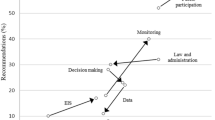Abstract
A post-project audit was conducted of 239 impacts forecast in an representative cross-section of 29 U.S. environmental impact statements. Results must be qualified because of the imprecision of EIS forecasts and the quality of data available to a retrospective evaluator. Relatively few forecasts were found to be inaccurate and even fewer unanticipated impacts were identified. However, only 30% of the impacts were unqualifiedly close to their forecasts, with almost as many rated accurate principally by virtue of the vagueness of the forecasts.
Similar content being viewed by others
References
Andrews, R. N. L.: 1976, Environmental Policy and Administrative Change: Implementation of the National Environmental Policy Act, D.C. Heath, Lexington, Mass.
Beanlands, G. E. and Duinker, P. N.: 1983, An Ecological Framework for Environmental Impact Assessment in Canada, Institute for Resource and Environmental Studies, Dalhousie University, Halifax, Nova Scotia.
Bisset, R.: 1984, ‘Post-Development Audits to Investigate the Accuracy of Environmental Impact Predictions’, Zeitschrift für Umweltpolitik, 463–484.
Brewer, G. and deLeon, P.: 1983, The Foundation of Policy Analysis, Dorsey Press, Homewood, Ill.
Caldwell, L. K.: 1982, Science and the National Environmental Policy Act, University of Alabama Press, University, Ala.
Canter, L. W.: 1977, Environmental Impact Assessment, McGraw Hill, New York.
Commoner, B.: 1971, The Closing Circle, Knopf, New York.
Cook, T. D. and Campbell, D. T.: 1979, Quasi-Experimentation: Design and Analysis Issues for Field Settings, Houghton Mifflin, Boston.
Cortner, H.: 1976, ‘A Case Analysis of Policy Implementation: The National Environmental Policy Act of 1969’, Natural Resources Journal 16, 323–338.
Culhane, P. J., Armentano, T. V., and Friesema, H. P.: 1985, ‘State-of-the-Art Science and Environmental Assessments: The Case of Acid Deposition’, Environmental Management 9, 365–378.
Culhane, P. J., Friesema, H. P., and Beecher, J. A.: forthcoming, Forecasts and Environmental Decisionmaking: The Contents and Accuracy of Environmental Impact Statements, Report to the National Science Foundation under Grant PRA-8119299, Westview Press, Boulder, Colo.
Environmental Resources Ltd.: 1984, Prediction in Environmental Impact Assessment, Ministerie van Volkshuisvesting, Ruimtelijke Ordening en Milieubeheer, 's-Gravenhage, the Netherlands.
Fairfax, S. and Andrews, B.: 1979, ‘Debate Within and Debate Without: NEPA and the Redefinition of the ‘Prudent Man’ Rule’, Natural Resources Journal 19, 505–536.
Friesema, H. P. and Culhane, P. J.: 1976, ‘Social Impacts, Politics, and the Environmental Impact Statement Process’, Natural Resources Journal 16, 339–356.
Kmenta, J.: 1971, Elements of Econometrics, New York, Macmillan.
Krippendorff, K.: 1980, Content Analysis, Sage, Beverly Hills, Calif.
Liroff, R. A.: 1976, A National Policy for the Environment: NEPA and Its Aftermath, Indiana University Press, Bloomington, Ind.
Loucks, O. L. (ed.): 1982, ‘Evaluating and Predicting Ecological Effects of Coal Combustion for Electric Power: An Overview of the Wisconsin Power Plant Study’, discussion draft ms., Indianapolis, Ind., and Madison, Wisc., January, 203 pp.
Murdock, S. H., Leistritz, F. L., Hamm, R. R., and Hwang, S.: 1982, ‘An Assessment of Socioeconomic Assessments: Utility, Accuracy, and Policy Considerations’, Environmental Impact Assessment Review 3, 333–350.
Quade, E. S.: 1964, ‘Systems Analysis Techniques for Public Policy-making’, Rand Corp., Santa Monica, Calif., March.
Stimson, J. A.: 1985, ‘Regression in Time and Space: A Statistical Essay’, American Journal of Political Science 29, 914–947.
Taylor, S.: 1984, Making Bureaucracies Think: The Environmental Impact Statement Strategy of Administrative Reform, Stanford University Press, Stanford, Calif.
U.S. Environmental Protection Agency: 1980, ‘Cumulative Index of Environmental Impact Statements, arranged by Agency and Bureau’, [computer printout] EPA Office of Federal Activities, Washington, D.C., May 28.
Wichelman, A.: 1976, ‘Administrative Agency Implementation of the National Environmental Policy Act of 1969’, Natural Resources Journal 16, 263–300.
Author information
Authors and Affiliations
Rights and permissions
About this article
Cite this article
Culhane, P.J. The precision and accuracy of U.S. environmental impact statements. Environ Monit Assess 8, 217–238 (1987). https://doi.org/10.1007/BF00404266
Issue Date:
DOI: https://doi.org/10.1007/BF00404266




